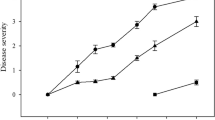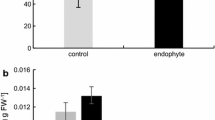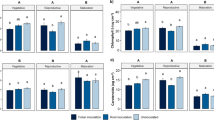Abstract
Key message
Photosynthetic and morphological differences between suitable ( Dalbergia sissoo, Lonicera japonica ) and unsuitable ( Aquilaria sinensis ) hosts in their semiparasitic associations with Santalum album were assessed.
Abstract
Santalum album L. is an important semiparasitic tree whose roots join to host roots, through haustoria, to acquire water and nutrients. Yet little is known how different hosts affect S. album growth, photosynthetic performance and haustorial development. In this study, Dalbergia sissoo Roxb., a leguminous tree, and Lonicera japonica Thunb., a non-leguminous vine, were suitable hosts while Aquilaria sinensis (Lour.) Gilg, a non-leguminous tree, was not. The three host plants were cultivated with sandalwood seedlings for 1 year, inducing significant differences in net photosynthetic rate, stomatal conductance and transpiration rate, plant height, haustorial size and number of haustoria. S. album growth was strongly related to net photosynthetic rate, stomatal conductance and transpiration rate. Well-formed and frequently replaced haustoria in the good host D. sissoo likely enhanced metabolism and nutrient transport. Ultrastructural observations showed differences in the interfacial region and internal structure between finger parenchymal cells and host root cells, vascular tissue, the reaction of host root cells and penetration modes. Among them, the finger parenchymal cells in the haustoria that connected with hosts D. sissoo and L. japonica roots were rich in organelles, including mitochondria, endoplasmic reticulum and lysosomes. Numerous small vacuoles accumulated inside membranes of the host root cells and finger parenchymal cells. Many lysosomes were present at the interfacial region where large-scale digestion of the host root cells in D. sissoo and L. japonica occurred. In contrast, in the finger parenchymal cells of the haustoria that joined to A. sinensis roots, organelles were not that obvious and black-stained material at the interfacial regions was indistinct. The modes of invasion were also different. The finger parenchymal cells penetrated into the roots of hosts D. sissoo and L. japonica by cell membrane fusion, pressure and degrading enzymes while in A. sinensis, host root cells were surrounded by the finger parenchymal cells and were self-digested. Even though mature haustoria could penetrate into the root xylem of hosts D. sissoo and A. sinensis, the haustoria that connected with D. sissoo had a mature xylem while A. sinensis had not yet formed any vessel elements. In all S. album haustoria connected to the three host roots, the vascular system developed some xylem but no phloem was observed.




Similar content being viewed by others
References
Baldovini N, Delasalle C, Joulain D (2011) Phytochemistry of the heartwood from fragrant Santalum species: a review. Flav and Frag J 26:7–26
Bell TL, Adams MA (2011) Attack on all fronts: functional relationships between aerial and root parasitic plants and their woody hosts and consequences for ecosystems. Tree Physiol 31:3–15
Burdock GA, Carabin IG (2008) Safety assessment of sandalwood oil (Santalum album L.). Food Chem Toxicol 46:421–432
Calladine A, Pate JS (2000) Haustorial structure and functioning of the root hemiparasitic tree Nuytsia floribunda (Labill.) R. Br. and water relationships with its hosts. Ann Bot 85:723–731
Cameron DD, Seel WE (2007) Functional anatomy of haustoria formed by Rhinanthus minor: linking evidence from histology and isotope tracing. New Phytol 174:412–419
Chen R, Zhang XH, Ma GH (2014) Studies on parasitic relationship between Santalum album L. and leguminous plants. J Trop Subtrop Bot 22:53–60 (in Chinese with English abstract)
Dobbin AR, Kuijt J (1974) Anatomy and fine structure of the mistletoe haustorium (Phthirusa pyrifolia). I. Development of the young haustorium. Am J Bot 61:535–543
Fineran BA (1979) Ultrastructure of differentiating graniferous tracheary elements in the haustorium of Exocarpus bidwillii (Santalaceae). Protoplasma 98:199–221
Fineran BA (1983) Ultrastructure of graniferous tracheary elements in the terrestrial mistletoe Nuytsia floribunda (Loranthaceae). Protoplasma 116:57–64
Fineran BA (1985) Graniferous tracheary elements in haustoria of root parasitic angiosperms. Bot Rev 51:389–441
Fineran BA, Coetzee J (1987) The apoplastic continuum, nutrient absorption and plasmatubules in the dwarf mistletoe Korthalsella lindsaji (Viscaceae). Protoplasma 136:145–153
Fosberg FR, Sacher MH (1985) Santalum in Eastern Polynesia. Candollea, pp 459–470
George AS (1984) Flora Australia (Santalaceae) Canberra: Australian Government Publishing Service 22:61–67
Guleria V (2013) Analysis of plant, host and management relationships for sandalwood (Santalum album) cultivation in new subtropical locality of hill region of Indian Himalayas. Ind For 139:53–57
Heide-Jorgensen HS (1989) Development and ultrastructure of the haustorium of Viscum minimum I. The adhesive disc. Can J Bot 67:1161–1173
Jensen WA (1963) Botanical histochemistry: principles and practice. Science 140:634–635
Joel DM, Losner-Goshen D (1994) Early host-parasite interaction: models and observations of host root penetration by the haustorium of Orobanche. J Exp Bot 55:2323–2329
Kim SK, Son TK, Park SY, Lee IJ, Lee BH, Kim HY, Lee SC (2006a) Influences of gibberellin and auxin on endogenous plant hormone and starch mobilization during rice seed germination under salt stress. J Environ Biol 27:181–186
Kim TH, Ito H, Hayashi K, Hasegawa T, Machiguchi T, Yoshida T (2006b) New antitumor sesquiterpenoids from Santalum album of Indian origin. Tetrahedron 62:6981–6989
Kuijt J (1969) The biology of parasitic flowering plants. Univ Calif Press 16:1081–1082
Kuijt J, Dobbins DR (1972) Studies on the haustorium of Castilleja (Scrophulariaceae) II. The endophyte. Can J Bot 51:923–931
Kuo J, Pate JS, Davidson NJ (1989) Ultrastructure of the haustorial interface and apoplastic continuum between host and the root hemiparasite Olax phyllanthi (Labill.) R.Br. (Olacaceae). Protoplasma 150:27–39
Li YL (2003) Introduction of Santalum album. Science Press, Beijing
Losner-Goshen D, Portnoy VH, Mayer AM, Joel DM (1998) Pectolytic activity by the haustorium of the parasitic plant Orobanche L. (Orobanchaceae) in host roots. Ann Bot 81:319–326
Lu JK, Kang LH, Sprent JI, Xu DP, He XH (2013) Two-way transfer of nitrogen between Dalbergia odorifera and its hemiparasite Santalum album is enhanced when the host is effectively nodulated and fixing nitrogen. Tree Physiol 33:464–474
Lu JK, Kang LH, Sprent JI, Xu DP, He XH (2014) Host-species-dependent physiological characteristics of hemiparasite Santalum album in association with N2-fixing and non-N2-fixing hosts native to southern China. Tree Physiol 34:1006–1017
Ma GH, He YM, Zhang JF, Chen FL (2005) Study on semi-parasitism of sandalwood seedlings. J Trop Subtrop Bot 13:233–238 (in Chinese with English abstract)
Musselman LJ, Dickison WC (1975) The structure and development of the haustorium in parasitic Scrophulariaceae. Bot J Linn Soc 70:183–212
Nagar N, Singh M, Sanwal GG (1983) Cell wall degrading enzymes in Cuscuta reflexa and its hosts. J Exp Bot 35:1104–1112
O’Brien TP, McCully ME (1982) The study of plant structure: principles and selected methods. J Ecol 70:699
Pate JS (2001) Haustoria in action: case studies of nitrogen acquisition by woody xylem-tapping hemiparasites from their hosts. Protoplasma 215:204–217
Pate JS, Kuo J, Davidson NJ (1990) Morphology and anatomy of the haustorium of the root hemiparasite Olax phyllanthi (Olacaceae), with special reference to the haustorial interface. Ann Bot 65:425–436
Radomiljac AM, McComb JA, Pate JS, Tennakoon KU (1998) Xylem transfer of organic solutes in Santalum album L. (Indian sandalwood) in association with legume and non-legume hosts. Ann Bot 82:675–682
Radomiljac AM, McComb JA, Pate JS (1999a) Gas exchange and water relations of the root hemi-parasite Santalum album L. in association with legume and non-legume hosts. Ann Bot 83:215–224
Radomiljac AM, McComb JA, Pate JS (1999b) Heterotrophic carbon gain and mineral nutrition of the root hemi-parasite Santalum album L. in pot culture with different hosts. Aust Forest 62:128–138
Rao LN (1942) Parasitism in the Santalaceae. Ann Bot 6:131–150
Rümer S, Cameron DD, Wacker R, Hartung W, Jiang F (2007) An anatomical study of the haustoria of Rhinanthus minor attached to roots of different hosts. Flora 202:194–200
Sharkey TD, Bernacchi CJ, Farquhar GD, Singsaas EL (2007) Fitting photosynthetic carbon dioxide response curves for C3 leaves. Plant Cell Envir 30:1035–1040
Tennakoon KU, Cameron DD (2006) The anatomy of Santalum album (sandalwood) haustoria. Can J Bot 84:1608–1616
Wagner WL, Warren L, Herbst DR, Sohmer SH (1990) Manual of the flowering plants of Hawaii. Revised Edition. University of Hawaii Press and Bishop Museum Press, Honolulu 2:1216–1223
Walker B, Strand D, Kramer D, Cousins A (2014) The response of cyclic electron flow around photosystem I to changes in photorespiration and nitrate assimilation. Plant Physiol 165:453–462
Yang XY, Zhang XH, Teixeira da Silva JA, Liang KM, Deng RF, Ma GH (2014) Ontogenesis of the collapsed layer during haustorium development in the root hemi-parasite Santalum album Linn. Plant Biol 16:282–290
Zhang XH, Teixeira da Silva JA, Duan J, Deng RF, Xu XL, Ma GH (2012) Endogenous hormone levels and anatomical characters of haustoria in Santalum album L. seedlings before and after attachment to the host. J Plant Physiol 169:859–866
Zinder SH (1993) Physiological ecology of methanogens. In: Ferry JG (ed) Methanogenesis. Chapman and Hall, New York
Acknowledgments
This work was supported by the National Natural Science Foundation of China (Grant numbers 31470685, 31100498, 31270720 and 30972295).
Author information
Authors and Affiliations
Corresponding authors
Ethics declarations
Conflict of interest
The authors declare no conflicts of interest.
Additional information
Communicated by U. Lüttge.
Rights and permissions
About this article
Cite this article
Ouyang, Y., Zhang, X., Chen, Y. et al. Growth, photosynthesis and haustorial development of semiparasitic Santalum album L. penetrating into roots of three hosts: a comparative study. Trees 30, 317–328 (2016). https://doi.org/10.1007/s00468-015-1303-3
Received:
Revised:
Accepted:
Published:
Issue Date:
DOI: https://doi.org/10.1007/s00468-015-1303-3




